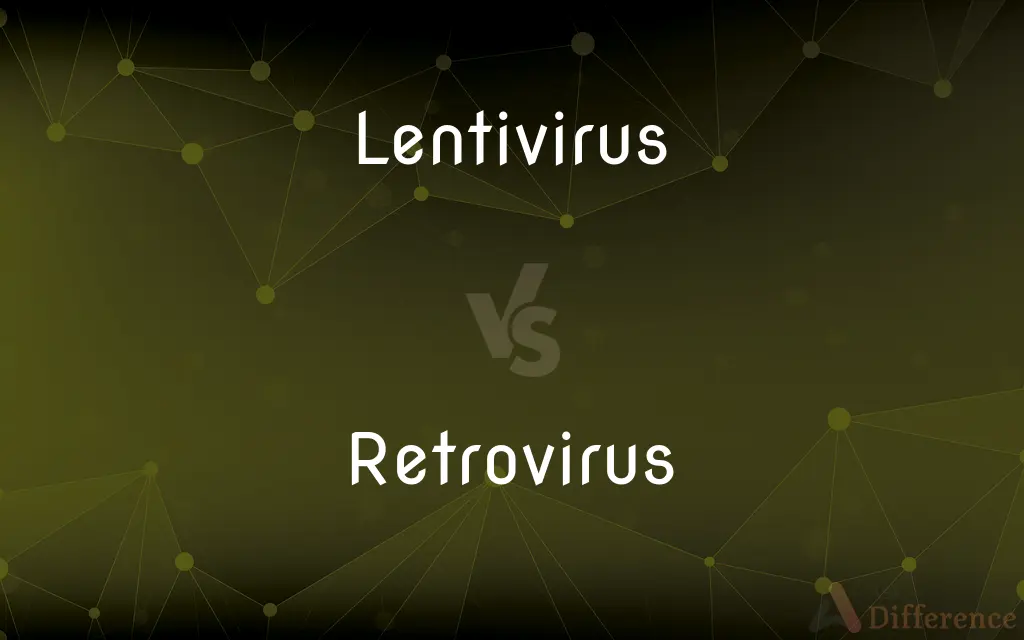Lentivirus vs. Retrovirus — What's the Difference?
Edited by Tayyaba Rehman — By Maham Liaqat — Updated on March 20, 2024
Lentivirus is a subclass of retroviruses known for slow disease progression, while retroviruses are a broader family of viruses that reverse-transcribe RNA into DNA to integrate into the host genome.

Difference Between Lentivirus and Retrovirus
Table of Contents
ADVERTISEMENT
Key Differences
Lentiviruses represent a specific group within the larger retrovirus family, characterized by their long incubation periods and ability to infect non-dividing cells. Retroviruses, in general, are defined by their unique replication process involving reverse transcription, where viral RNA is converted into DNA, which then integrates into the host's genome. This process is fundamental to both lentiviruses and other retroviruses, but lentiviruses are particularly noted for their capacity to cause chronic and progressive diseases.
One of the most well-known examples of a lentivirus is the Human Immunodeficiency Virus (HIV), which can lead to Acquired Immunodeficiency Syndrome (AIDS) after a prolonged period. This contrasts with some retroviruses that might induce quicker disease onset. Lentiviruses' ability to infect both dividing and non-dividing cells broadens their range of potential host cells, including neurons, which are typically non-dividing.
Both lentiviruses and other retroviruses share the retroviral hallmark of integrating their genetic material into the host's DNA, which can lead to persistent infections. However, lentiviruses are distinguished by their complex regulatory and accessory genes, which contribute to their prolonged latency period and evasion of the host's immune response.
In research and therapeutic applications, lentiviruses are often engineered as vectors for gene therapy due to their ability to integrate therapeutic genes into the host genome, offering potential for long-term treatment of genetic disorders. This application capitalizes on their ability to infect non-dividing cells, a feature not as commonly exploited with other retroviruses.
Understanding the differences between lentiviruses and retroviruses is crucial in virology and therapeutic research, as it informs the development of treatments and vaccines. While lentiviruses are a subset of retroviruses with specific characteristics, all retroviruses share the fundamental mechanism of reverse transcription for replication within the host.
ADVERTISEMENT
Comparison Chart
Definition
A subclass of retroviruses with long incubation periods
A family of viruses that reverse-transcribe RNA into DNA
Incubation Period
Long, leading to chronic diseases
Varies, can be shorter than lentiviruses
Infection Capability
Can infect dividing and non-dividing cells
Primarily infects dividing cells
Diseases
HIV/AIDS is a notable example
Includes HTLV-1 and other oncogenic viruses
Genetic Complexity
More complex with additional regulatory and accessory genes
Less complex compared to lentiviruses
Research Applications
Used in gene therapy for stable gene delivery
Used in research, less commonly in gene therapy due to integration preferences
Compare with Definitions
Lentivirus
Infects non-dividing cells.
Lentiviruses can infect neurons, which are non-dividing cells.
Retrovirus
Genome integration.
The DNA of retroviruses integrates into the host's genome.
Lentivirus
Slow progression.
Lentiviral infections often progress to disease slowly.
Retrovirus
Oncogenic potential.
Certain retroviruses are associated with cancer development.
Lentivirus
Chronic infection.
HIV, a type of lentivirus, can lead to AIDS over many years.
Retrovirus
Diverse diseases.
Retroviruses can cause a range of diseases, from tumors to immunodeficiencies.
Lentivirus
Gene therapy vectors.
Engineered lentiviruses are used to deliver therapeutic genes.
Retrovirus
Reverse transcription.
Retroviruses convert their RNA into DNA inside the host cell.
Lentivirus
Complex genome.
Lentiviruses possess additional genes aiding in immune evasion.
Retrovirus
Research and therapy.
Retroviruses are studied for their unique replication mechanism and potential in gene therapy.
Lentivirus
Lentivirus is a genus of retroviruses that cause chronic and deadly diseases characterized by long incubation periods, in the human and other mammalian species. The best known lentivirus is the human immunodeficiency virus (HIV), which causes AIDS. Lentiviruses are also hosted in apes, cows, goats, horses, cats, and sheep.
Retrovirus
A retrovirus is a type of virus that inserts a copy of its RNA genome into the DNA of a host cell that it invades, thus changing the genome of that cell. Once inside the host cell's cytoplasm, the virus uses its own reverse transcriptase enzyme to produce DNA from its RNA genome, the reverse of the usual pattern, thus retro (backwards).
Lentivirus
Any of a group of retroviruses of the genus Lentivirus that cause diseases with a long latent period and a slow, progressive course. HIV is a lentivirus.
Retrovirus
Any of a family of viruses, many of which produce tumors, that contain RNA and reverse transcriptase, including HIV.
Lentivirus
Any of a group of retroviruses, of the genus Lentivirus, which have long incubation periods.
Retrovirus
(virology) Any of a group of viruses which insert a copy of their RNA genome into the DNA of a host cell, thus changing the genome of that cell.
Retrovirus
(computer security) A computer virus that seeks to attack antivirus programs in an attempt to avoid detection.
Retrovirus
Any of a group of viruses that contain two single-strand linear RNA molecules per virion and reverse transcriptase (RNA to DNA)
Common Curiosities
How do retroviruses replicate?
Retroviruses replicate by reverse-transcribing their RNA genome into DNA, which then integrates into the host cell's genome, allowing it to be replicated along with the host's DNA.
Why are lentiviruses important in gene therapy?
Lentiviruses are valuable in gene therapy due to their ability to deliver and integrate therapeutic genes into the genomes of non-dividing cells, offering potential for long-term treatment.
Can all retroviruses infect non-dividing cells?
No, this ability is more characteristic of lentiviruses, a subgroup of retroviruses.
What is the main difference between lentivirus and retrovirus?
The main difference is that lentiviruses are a specific subtype of retroviruses known for their long incubation periods and ability to infect non-dividing cells.
Are all retroviruses harmful?
While many retroviruses are pathogenic, causing diseases in their hosts, not all retroviruses necessarily lead to harmful outcomes; some may remain latent or be controlled by the host's immune system.
What makes lentiviruses unique among retroviruses?
Lentiviruses are unique for their complex genome, which includes additional regulatory and accessory genes that contribute to their long incubation period and chronic disease progression.
How is HIV related to lentiviruses and retroviruses?
HIV is a type of lentivirus, which in turn is a subgroup of retroviruses. It shares the retroviral replication mechanism but has specific characteristics like a long incubation period and complex gene regulation.
What are the therapeutic applications of retroviruses?
Beyond lentiviral applications in gene therapy, retroviruses are studied for vaccine development and as models to understand viral integration and gene regulation.
How do lentiviruses evade the immune system?
Lentiviruses have complex regulatory and accessory genes that help them avoid detection and destruction by the host's immune system, contributing to their ability to cause chronic infections.
Is gene therapy with lentiviruses safe?
Gene therapy using engineered lentiviruses is considered promising but is subject to rigorous testing and regulatory approval to ensure safety and efficacy.
Can retroviruses be beneficial?
Some research suggests retroviruses have played roles in evolutionary processes, such as contributing to the human genome in ways that may have conferred advantages or influenced development.
Can lentiviruses cause cancer?
While lentiviruses like HIV are primarily associated with immunodeficiency diseases, some retroviruses, which are a broader category including lentiviruses, have been linked to cancer.
What is the significance of reverse transcription in retroviruses?
Reverse transcription allows retroviruses to integrate their genetic material into the host's DNA, a key step in their replication cycle and a target for antiviral therapies.
Share Your Discovery

Previous Comparison
Inspection vs. Observation
Next Comparison
Nursery vs. PlaygroupAuthor Spotlight
Written by
Maham LiaqatEdited by
Tayyaba RehmanTayyaba Rehman is a distinguished writer, currently serving as a primary contributor to askdifference.com. As a researcher in semantics and etymology, Tayyaba's passion for the complexity of languages and their distinctions has found a perfect home on the platform. Tayyaba delves into the intricacies of language, distinguishing between commonly confused words and phrases, thereby providing clarity for readers worldwide.
















































